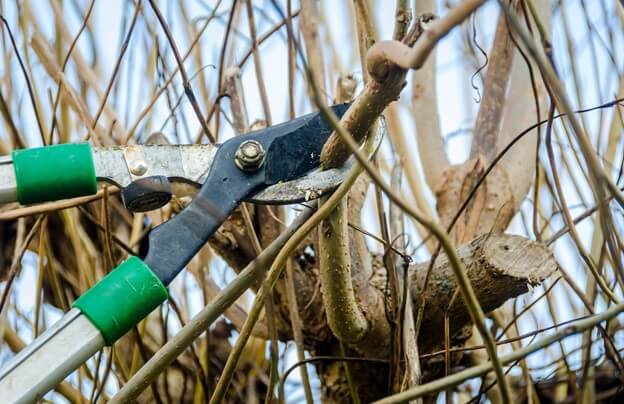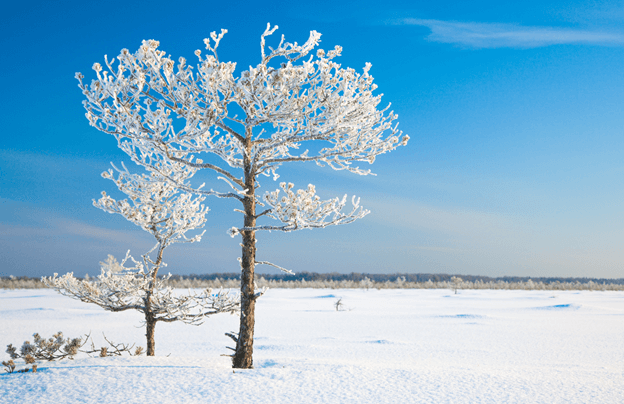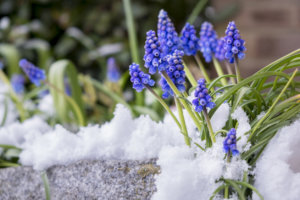
How to Care for Trees in Winter in Colorado
Updated: February 25, 2022
Denver weather is unpredictable—which means winter tree care is a necessity! Winter Tree Care in Colorado is mission-critical when maintaining a healthy outdoor space. The spring season often brings unexpected and heavy snowstorms. In fact, spring snow in Denver is typically wet and heavy snow which is damaging to our trees. We will discuss handling everything from broken tree branch removal, to reshaping a tree after damage, to emergency tree removal.
Winter Tree Care in Colorado
Mother nature’s biggest soldiers, life-givers, the tree. Our dormant giants go through it all; rain, snow, sleet, hail, remain standing at the end of the day. As intense as the conditions get, trees still require proper care, especially during the winter. With trees being exposed to all weather and conditions, it’s important to learn how to care for our big giants properly. Throughout the article, we will cover everything you need to know about caring for trees in winter to help minimize the stress in trees, watering, protectant techniques, and preparation before the winter season for tree care.

Common Winter Tree Care Issues
- Winter Burn: Dehydrated or damaged foliage and needles from the exteriors of evergreen and conifer plants.
- Why does it happen?
- In Colorado, it can get dry and windy to the point where a tree cannot collect enough moisture
- How can it be prevented?
- You can apply a layer of antitranspirant spray to retain moisture
- Insulating the tree with wraps from dryness and slowing down the transpiration process
- Why does it happen?
- Susceptibility to Salt Damage: Build-up of salt that stunts plant growth; it creates stress that is shown through the tree even after being watered, and could lead to the downfall of the tree itself. Although de-icing salts can help keep pavements dry and safe during snow, they can be detrimental to trees.
- Why does it happen?
- The salt will prevent the nutrients to be absorbed
- Salt deposits that are in the soil are pulled up through the stems, contaminating everything from the roots, eventually spreading to the roots, branch tips, and buds.
- How can it be prevented?
- Avoid using salt, use things like coarse sand or de-icing mediums like calcium-chloride or calcium magnesium acetate to reduce the usage of heavy salts.
- Watering your soil to leach out the salt. Salt is water-soluble, making it easier and more effective to filtrate the salt from the root zones.
- Cold Stress: Tree stress comes in many forms causing the tree to crack between the bark and the inner wood.
- Why does it happen?
- Commonly happens when a tree suffers from rapidly changing weather. Ex: Daytime heat and then freezing nightly weather.
- Early growth gets stunted by cold weather and frost
- How can it be prevented?
- Avoid pruning new growth areas, it is best to wait until the tree goes into dormancy to treat areas with frost damage.
- Wrapping the tree can help with retaining moisture, crack treatment, and control the susceptibility of damage due to weather.
- Why does it happen?
- Winter Drought: With the ground being frozen during the winter, it becomes difficult for trees to absorb water.
- Why does it happen?
- Frozen ground or abnormal times when snowfall doesn’t come around (dry-season), there becomes a lack of moisture in the ground.
- Usually occurs for newly planted trees, evergreens, and deciduous trees like Oaks, Maples, Willows, and Ash trees.
- How can it be prevented?
- Winter watering and mulching techniques are effective against winter drought.
- Why does it happen?
- Branch Damage: Brittle tree branches break due to environmental factors, disease, age, and even in many cases breaking by their weight.
- Why does it happen?
- Over time, especially with trees that shed their leaves annually, the wood in the tree hardens and becomes weaker during the winter. This makes them more vulnerable to breakage, wind damage, and snow accumulation
- How can it be prevented?
- Perform routine inspections to revise weak or brittle branches
- Pruning the weak or brittle branches
- Using material to cover the tree or using rope to reinforce the branches
- Why does it happen?
- Why does it happen?

Tree Care
Tree Trimming and Pruning in Winter
- Tree Pruning is best done during winter (mid-late winter is best)
- Diseases are dormant during the wintertime, best to get ahead and stop diseases from spreading. Ex: Fire Blight, a tree disease that thrives in warm weather and easily spreads amongst trees.
- Nutrients and sugars are stored in the soil during this time
Watering
- According to Denver Water, trees should receive about 10 gallons of water per watering inch of the tree trunk diameter.
- Shrubs should receive about 5-18 gallons of water, varying on their size.
- Be cautious when watering
- In many cases watering too much or watering too little can dictate the health of a tree.
Wrapping
- Reduces different types of damages to be exposed from Ice damage, salt damage, moisture loss, animals, and weather damage. Can be done by applying a specific material wrap (paper, burlap, etc.)
- Tree wrapping also helps fight sun scalding. Sun scalding is tissue damage in a tree when the bark freezes and expands through warmer weather.
- Thinner trees like Maples cannot expand quickly enough for the moisture to get through.
- Bigger trees like the Oaks, Aspens, and Conifers are bigger and can adjust to the aggressive changes in the weather.
Mulch
- It is recommended to apply mulch 2-3 inches to retain moisture and remain consistent with temperature changes.
Winter animal protection
- Rodents and other animal species tend to eat on the tree bark as a food source and begin to girdle the tree (entire removal of bark from the circumference of a branch or trunk).
- There are various ways to prevent animals from intruding like using wrapping materials, repellants, and spacing techniques when applying mulch.
Fertilizer
- Fertilizing your trees in late fall or during the winter helps the tree grow during its dormancy state. It also helps store nutrients and prepares the tree for better growth in the springtime
- Make sure to check your growing zone, this can be a factor in whether or not it is the time to fertilize or not
- Do not apply fertilizer to frozen ground, it will not be absorbed
- Also, avoid fertilizing when it is early fall or in warm conditions. New growth will be stunned and suffer damage through frigid temperatures as the season rolls through
Professional Winter Tree Care
In Colorado, there are a common number of tree issues that are always in occurrence due to improper tree care, environmental factors, or old age. At Environmental Designs, our Arbor division takes care of many of these issues to keep you and your trees safe.

Broken Tree Branch Removal
Accumulated snow and ice can cause limbs to break and fall anytime. Weaker branches are susceptible to breakage. If you choose to knock off the snow off on the limbs you can reach, always keep in mind that safety should be your number one priority. Some branches may be weak and barely hanging on to the others that may end up in broken branches. Our tree experts can remove broken branches that fall on your property. Sometimes large sections of a weakened tree will break due to heavy snow.

Reshaping Trees, Structural Pruning & Canopy Thinning
Winter snowstorms in Denver typically cause quite a lot of branch breakage. The heavyweight of snow can actually cause branches to look out of shape or become structurally weakened. Once these are cleaned up, trees can sometimes look a little misshapen. Our Arborists are experts at reshaping trees and structurally pruning out the weaker limbs to prevent damage in the future. We also offer canopy thinning which will clear out all the dead and useless limbs in the canopy. Canopy thinning helps provide the removal of clumped or dead limbs inside of the canopy. This process is vital in order to have less surface area for snow to land during the winter storms as well.
Building Clearance Pruning
Without a storm, if a tree grows too close to a building branches can rub on the building. If there is a snowstorm the weight of the snow can bring the branch lower onto the building and/or damage other objects around it. In order to prevent damage from this happening, our Arbor team will perform a crown reduction to get more space between the building and the tree to make sure branches don’t damage the building or the branches themselves. Crown reductions are best for these problems as it gives space between the tree and the building.

Emergency Tree Branch Removal
Expect the unexpected. Without taking the proper trimming and maintenance measures for your trees it may fail. Some of the reasons a tree could fail could be from damage to the root system, disease and pests, or it could be storm-related and too much weight on the branches from the heavy snow and winds may cause a tree to fail. If this happens, do not fret! Whether the tree falls on the ground, on part of a building, or on a car, we can help take care of it for you!

Winter Prep Checklist
The winter season brings along everything from freezing weather, dryness, and the bright white shine of the snow. Like many, the winter season invites hibernation for many species, but more importantly, trees, plants, and other living habitants go into their dormant state.
Essentially, giving us the hint in the fall that they are gonna be resting for a little while. That being said, it is then the perfect time to prepare the trees and shrubs for their health and longevity as the cold weather arrives. Below is a checklist of things to review to keep your trees and shrubs healthy over the winter season.
- Tree Pruning and Trimming
- Pruning, checking overall health and shape
- Pruning can help create future growth
- Effective management over the shape and structure of the tree
- During a tree’s dormant state, that is the best time to eliminate the dead, plagued, or damaged branches from a tree.
- Pruning, checking overall health and shape
- Inspect Trees
- Overall evaluations can help with identifying underlying issues that could lead to damage or breakage of the winter course.
- Check for frost damage
- Insect and disease damage
- Overall evaluations can help with identifying underlying issues that could lead to damage or breakage of the winter course.
- Evaluate your soil
- Your ground may freeze during the winter, but it’s best to make sure that the soil retains moisture and is packed with nutrients.
- Check for salt deposits and avoid rock salt usage
- Make sure your trees and shrubs are properly fertilized
- Your ground may freeze during the winter, but it’s best to make sure that the soil retains moisture and is packed with nutrients.
- Tree and Shrub Protection
- Wrapping and Tree protection can minimize the harm from unpredictable weather, animals, and other discourageable damage done.
- Wrap and cover your trees or shrubs
- Apply protectant for pests and loss of moisture
- Snow removal from trees
- Wrapping and Tree protection can minimize the harm from unpredictable weather, animals, and other discourageable damage done.

Learn the importance of tree maintenance and care
Experts at Winter Tree Care in Denver
Need Help from Landscape Professionals? If you are interested in protecting your trees for the winter and are ready to prepare them for the upcoming spring season, give our office a call! Our tree experts can help make sure your trees are growing safely and beautifully this season—contact us today.


